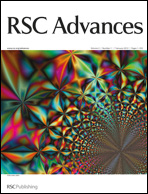Using a nanoporous alumina template, we prepared an isotactic polystyrene/poly(2,6-dimethylphenylene oxide) (iPS/PPO) nanorod blend with gradient composition and gradient crystallinity. The crystallinity, orientation and composition of the polymer in the nanorods were investigated by micro-FTIR spectroscopy. Although iPS and PPO are compatible at the molecular level, due to the viscosity difference between the two components, the polymer blend underwent phase separation during the capillary flow into the nanopores to form a gradient distributed composition in the nanorods. Along the growth direction (from the bottom to the top) of the nanorods, the iPS content increased, but the iPS crystallinity decreased due to crystallization initiated by the nuclei formed in the bulk and the constrained crystal growth. This finding provides a unique approach to the design and fabrication of novel nanomaterials with gradient properties in nanoscale engineering.
You have access to this article
 Please wait while we load your content...
Something went wrong. Try again?
Please wait while we load your content...
Something went wrong. Try again?


 Please wait while we load your content...
Please wait while we load your content...